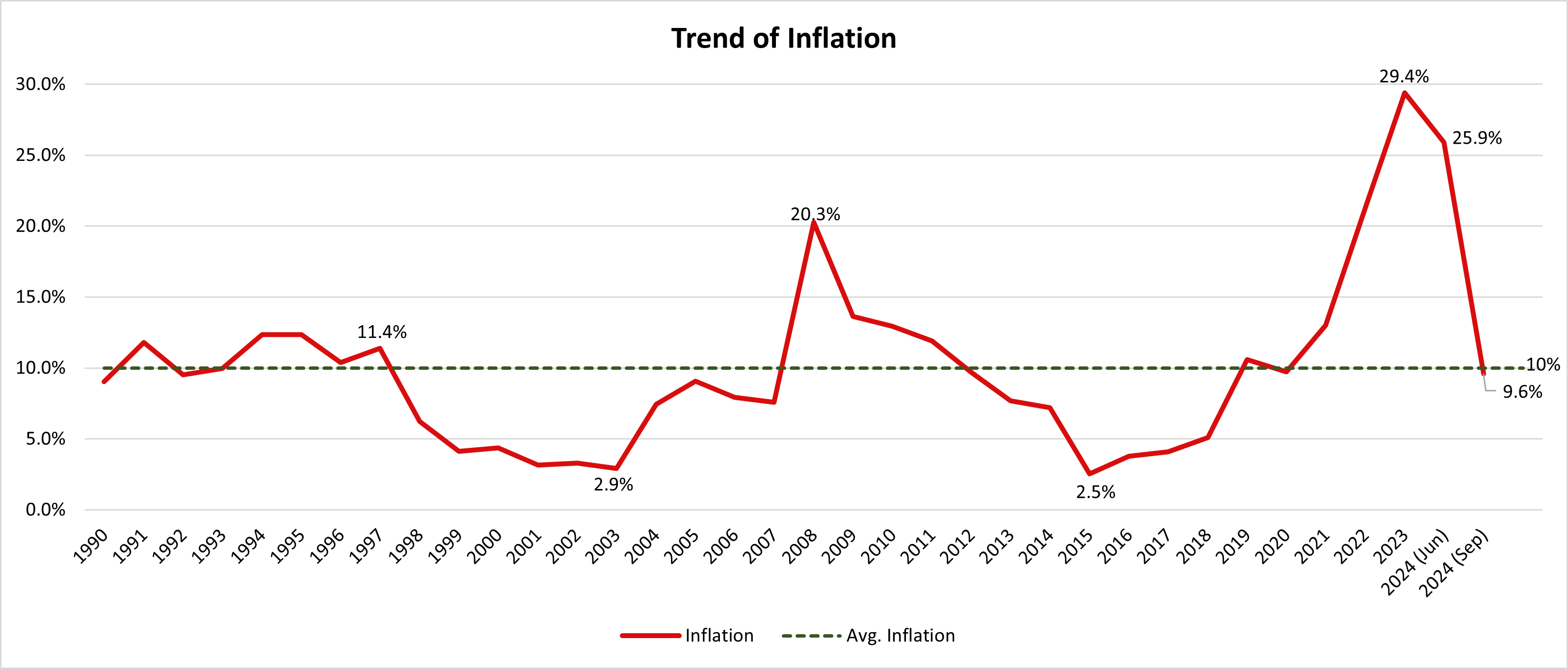Three things are guaranteed in life as a Pakistani:
1. Death
2. Loadshedding
3. Inflation
We can't escape the first; we have learned to live with the second. However, the third often catches us off guard until we realize that, despite earning more, we are still buying less, saving less, and feeling anxious about money all the time.
The concept of inflation means that prices for things will go up over time. This means that in the future, you might be able to afford fewer things with the same amount of money you have today.
Think of it as a slow leak in your wallet that drains the purchasing power of your savings over time.
Inflation is a fundamental aspect of our financial lives that we cannot deny or ignore. For anyone earning in Pakistani Rupees, this is a silent tax that we must pay.
According to the Pakistan Bureau of Statistics (PBS), Pakistan's inflation rate averaged around 10% per year [1] over the past decade, making everyday life increasingly expensive.
Everything costs a bit more now, from atta to electricity, petrol to school fees, and even a bag of cat food.
While it may not feel like a sudden blow, it's more like death by a thousand paper cuts, where your purchasing power keeps shrinking month after month.
What's even worse is that the salaries and income aren't keeping pace with inflation. So, even if you're earning more than you did five years ago, you might still feel stuck or falling behind in your finances.

According to Karandaaz, a liter of petrol was about Rs. 100 in 2020, but it is currently around Rs. 250. [2]
For the average Pakistani, the cost of living continues to rise daily, and action needs to be taken to address this issue.
Inflation isn't just a macroeconomic indicator. It affects our financial lives on a daily basis, so it is really important to put inflation into the right perspective.
Imagine you had stashed away Rs. 100,000 under your bed in 2011 and forgot about it, that same Rs. 100,000 would be worth just Rs. 28,000 in today's time, thanks to an average inflation rate of 10% per year. That's 70% of your purchasing power gone.
Now, imagine if you had invested that same Rs. 100,000 in KSE-100 which is like a basket of top 100 companies of Pakistan. Your same Rs. 100,000 would be worth close to Rs. 1 million now.
This means that your money not only nullified the impact of inflation, but you were also able to afford more things now.
That's the difference between letting your money shrink and letting it grow. Saving alone won't protect you. Investing is how you fight back.
To halt the financial drain on your wallet caused by inflation, you need to put your money to work so that it can grow for you.
This is where investing comes in. Investing is like buying something now that will make you more money in the future. The point is to let whatever money you have today make you more money in the future.
It's like planting a seed in the ground. You give it time, sunlight, water, and care, and one day, it'll grow into a tree and produce fruit.
Saving is like putting seeds in a jar. It's safe, but the seeds will never grow and will not yield fruit.
In reality, if you were not doing anything to grow your money other than to earn it, you were on the losing end of the bargain.
Yes, you can earn a lot of money, but if you aren't deliberately putting your money to work, the impact of inflation is still present. It's still eroding your savings if your savings aren't growing on their own.
You cannot grow your money by hiding it under the cushion. Rs. 100,000 hidden under the pillow will remain Rs. 100,000 even after 15 years. There's no progress. There's no growth. In fact, it has decreased in value.
This is why you feel anxious even after a raise. You're working harder, earning more, yet affording less.
For someone who only understands that they need to put their money to work, mutual funds are a great way to start their investing journey.
Investing in mutual funds is like giving your money to a trusted friend who knows the market thoroughly and understands how to grow it wisely. The best part? Mutual funds are fully regulated and managed by licensed professionals, ensuring your money remains safe, and they can't just disappear with it.
Here's how you can start with mutual funds:
1. Create an account with Harvest MFD
2. Complete your profile by filling out the required details
3. Select the fund you want to invest in based on your risk appetite and time horizon
4. Enter the amount you want to invest
5. Happy investing!
Inflation isn't going anywhere, but neither should your money. You don't need to be an expert to start investing, you need someone who's ready to take the first step.
And that's precisely what we're here for at Harvest MFD, to make investing simple, safe, and doable for people like you.